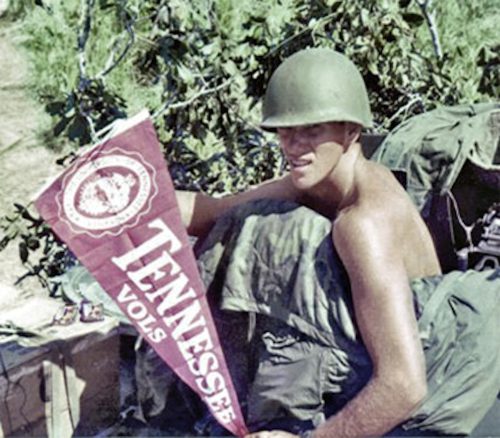
On February 15, 1968, during some of the heaviest fighting of the Tet Offensive, James T. (Tommy) Davis of Meigs County fell to enemy fire as a result of multiple shrapnel wounds. Six other East Tennesseans died during the campaign. Their bios can be found below.
On the early morning of January 30, 1968, Viet Cong forces attacked 13 cities in central South Vietnam, just as many families began their observances of the lunar new year.
Twenty-four hours later, PAVN and Viet Cong forces struck a number of other targets throughout South Vietnam, including cities, towns, government buildings and U.S. or ARVN military bases throughout South Vietnam, in a total of more than 120 attacks.
In a particularly bold attack on the U.S. Embassy in Saigon, a Viet Cong platoon got inside the complex’s courtyard before U.S. forces destroyed it. The audacious attack on the U.S. Embassy, and its initial success, stunned American and international observers, who saw images of the carnage broadcast on television as it occurred.
Though Giap had succeeded in achieving surprise, his forces were spread too thin in the ambitious offensive, and U.S. and ARVN forces managed to successfully counter most of the attacks and inflict heavy Viet Cong losses.
The Battle of Hue
Particularly intense fighting took place in the city of Hue, located on the Perfume River some 50 miles south of the border between North and South Vietnam.
The Battle of Hue would rage for more than three weeks after PAVN and Viet Cong forces burst into the city on January 31, easily overwhelming the government forces there and taking control of the city’s ancient citadel.
Early in their occupation of Hue, Viet Cong soldiers conducted house-to-house searches, arresting civil servants, religious leaders, teachers and other civilians connected with American forces or with the South Vietnamese regime. They executed these so-called counter-revolutionaries and buried their bodies in mass graves.
U.S. and ARVN forces discovered evidence of the massacre after they regained control of the city on February 26. In addition to more than 2,800 bodies, another 3,000 residents were missing, and the occupying forces had destroyed many of the city’s grand temples, palaces and other monuments.
The toughest fighting in Hue occurred at the ancient citadel, which the North Vietnamese struggled fiercely to hold against superior U.S. firepower. In scenes of carnage recorded on film by numerous television crews on the scene, nearly 150 U.S. Marines were killed in the Battle of Hue, along with some 400 South Vietnamese troops.
On the North Vietnamese side, an estimated 5,000 soldiers were killed, most of them hit by American air and artillery strikes.
“What I saw was probably the most intense ground fighting on a sustained basis over several days of any other period during the war,” Howard Prince, a U.S. Army captain, later told NPR.
“We didn’t know where the enemy was, in which direction even,” Mike Downs, a Marine captain, told NPR.
| Lay, Roger M. |
| McReynolds, George W. |
| Popkin, Steven J. |
| Reed, James E. |
| Ward Jr., John D. |

